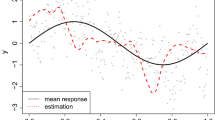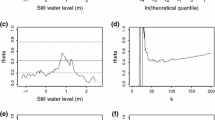Abstract
We propose a kernel density based estimation for multiplicative linear regression models. The method proposed in this article makes use of kernel smoothing nonparametric techniques to estimate the unknown density function of model error. For the hypothesis testing of parametric components, restricted estimators under the null hypothesis and test statistics are proposed. The asymptotic properties for the estimators and test statistics are established. We illustrate our proposals through simulations and an analysis of the QSAR fish bioconcentration factor data set. Our analysis provides strong evidence that the proposed kernel density based estimator is superior than the least squares estimator and least product relative error estimator in the literature, particularly for multimodal or asymmetric or heavy-tailed distributions of the model error.







Similar content being viewed by others
References
Chen K, Guo S, Lin Y, Ying Z (2010) Least absolute relative error estimation. J Am Stat Assoc 105(491):1104–1112
Chen K, Lin Y, Wang Z, Ying Z (2016) Least product relative error estimation. J Multivar Anal 144:91–98
Chen X, Ma X, Zhou W (2020) Kernel density regression. J Stat Plann Inference 205:318–329
Grisoni F, Consonni V, Villa S, Vighi M, Todeschini R (2015) Qsar models for bioconcentration: is the increase in the complexity justified by more accurate predictions? Chemosphere 127:171–179
Kolassa S, Martin R (2011) Percentage errors can ruin your day (and rolling the dice shows how). Foresight Int J Appl Forecast 23:21–27
Li G, Feng S, Peng H (2011) A profile-type smoothed score function for a varying coefficient partially linear model. J Multivar Anal 102(2):372–385
Liu H, Xia X (2018) Estimation and empirical likelihood for single-index multiplicative models. J Stat Plann Inference 193:70–88
Manski CF (1985) Semiparametric analysis of discrete response. Asymptotic properties of the maximum score estimator. J Econom 27(3):313–333
Manski CF (1975) Maximum score estimation of the stochastic utility model of choice. J Econom 3(3):205–228
Silverman BW (1986) Density estimation for statistics and data analysis. Vol. 26 of monographs on statistics and applied probability. Chapman and Hall, London
Tofallis C (2015) A better measure of relative prediction accuracy for model selection and model estimation. J Oper Res Soc 66(8):1352–1362
Zhang J, Feng Z, Peng H (2018) Estimation and hypothesis test for partial linear multiplicative models. Comput Stat Data Anal 128:87–103
Zhang J, Zhu J, Feng Z (2019) Estimation and hypothesis test for single-index multiplicative models. TEST 28(1):242–268
Zhang J, Cui X, Peng H (2020) Estimation and hypothesis test for partial linear single-index multiplicative models. Ann Inst Stat Math 72:699–740
Zhang J, Zhu J, Zhou Y, Cui X, Lu T (2020) Multiplicative regression models with distortion measurement errors. Stat Pap 61:2031–2057
Acknowledgements
The authors thank the editor, the associate editor, and two referees for their constructive suggestions that helped us to improve the early manuscript. Bingqing Lin’s research was supported by the National Natural Science Foundation of China (Grant No. 11701386), the Natural Science Foundation of Guangdong Province (Grant No. 2020A1515010372) and the University stability support program A of Shenzhen (Grant No. 20200813151828003). Jun Zhang’s research was supported by the Natural Science Foundation of Guangdong Province (Grant No. 2020A1515010372), and the University stability support program A of Shenzhen (Grant No. 20200813151828003). Yiping Yang is supported by the Social Science Planning Project of Chongqing (2019WT58), Natural Science Foundation of Chongqing (CSTC2020JCYJ-MSXMX006), the National Social Science Foundation of China (Grant No. 18BTJ035), Research Fund of Chongqing Technology and Business University (Grant No. 2019ZKYY119), 2018 Chongqing Statistics Postgraduate Tutor Team (YDS183002).
Author information
Authors and Affiliations
Corresponding author
Additional information
Publisher's Note
Springer Nature remains neutral with regard to jurisdictional claims in published maps and institutional affiliations.
Supplementary Information
Below is the link to the electronic supplementary material.
Rights and permissions
About this article
Cite this article
Zhang, J., Lin, B. & Yang, Y. Maximum nonparametric kernel likelihood estimation for multiplicative linear regression models. Stat Papers 63, 885–918 (2022). https://doi.org/10.1007/s00362-021-01258-9
Received:
Revised:
Accepted:
Published:
Issue Date:
DOI: https://doi.org/10.1007/s00362-021-01258-9
Keywords
- Kernel density based estimator
- Restricted estimator
- Least squares estimator
- Least product relative error




